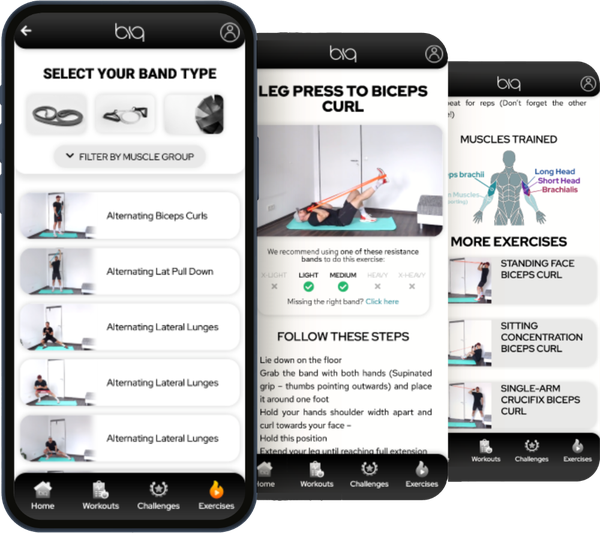This is probably the most important exercise for your general health and fitness. You should be doing squats on a regular basis, whether it be only with body weight or added resistance. Every muscle of your lower body will be active in a squat, in addition a lot of muscles in the upper body have to provide stabilization as well. The squat is basically a total body challenge, especially if you add a load to the movement.
By doing squats, you will develop a more muscular and stronger lower body, but also a functional body in general. In any sport, the lower body is heavily involved and most of the strength and explosive power will come from your legs and glutes. Since these muscles are the biggest and therefore also the strongest muscles in the entire human body, you can move quite some load even as a beginner. So you usually need a higher amount of weights to get an effective workout and going to a gym is the easiest way to get access to such amount of weights. However, this is where resistance bands come into play. Bands can generate enough resistance, so even strong lower body movements like squats and deadlifts become very challenging.
This article will be your guide to a perfect squat with resistance bands. We look at the basic squat and what steps to follow and form mistakes to avoid, to get it 100% right. We look at different methods to progress and at different variations to incorporate in your training. In the last section, we discuss if resistance bands are effective for leg training and what muscles will be involved in a squat. Finally, we finish it off with a quick look on the topic of workout programming regrading squats.
How To Squat The Right Way With Resistance Bands?
The first thing in resistance training should always be a warm-up. I know, I know… boring! You might think something like: “Really? Do I have to do it as well? I feel ready. Let’s do some squats already!” But trust me when I say that the boring stuff makes you have progress on a consistent basis and, more importantly, in the long run. A great way to warm up your lower body is by doing some jumping, a step in various directions where you go a little lower and actually squats simply with your body weight.
When it comes to equipment, you will actually just need a resistance band. However, we recommend getting a set of bands with different resistance levels (like this one: Resistance Bands Set). This way you can adjust the resistance by using a thinner band or combine two or more bands to make squats really challenging. Wearing shoes and gloves is a good idea as well, and I always do when using resistance bands. This will make the exercise much more comfortable on your feet and hands, since you won’t feel the friction generated by the bands on your skin. Full finger gloves (like these: Workout Gloves) are preferable to open finger versions.
Now we are ready to find out how to do a squat. There are 6 simple steps to get a squat with perfect form:
- Step with both feet shoulder width apart on the band
- Grab the band with both hands, bring your hands up and place the band on your shoulders (you will hold the band in front of your chest)
- Initiate the movement by bending your knees and driving your hips backwards
- Go down until your thighs are parallel to the floor (if you can go further down, even better)
- Reverse the movement by driving your hips forward and extending your legs at the same time
- Repeat for reps
The easiest way to hold the band in the squat set-up with resistance bands is by placing it on your shoulders and have your hands secure the band on the chest. The best way to get in this position is by starting with an underhand grip, do a little mini squad and bring your hands to your shoulders and at the same time lift the elbows. Now bring the elbows down and your hands in front of your chest. Done.
Common Form Mistakes
⓵ Avoid Rounding of the Back – probably the most common mistake(s) when it comes to squatting. A good form is having a neutral spine in a squat. There are two location where the rounding can happen – the upper and the lower back.
Avoiding the upper back rounding is quite simple and is often happening due to internally rotated shoulders. The key here is to stick your chest out and actively keeping your shoulders externally rotated.
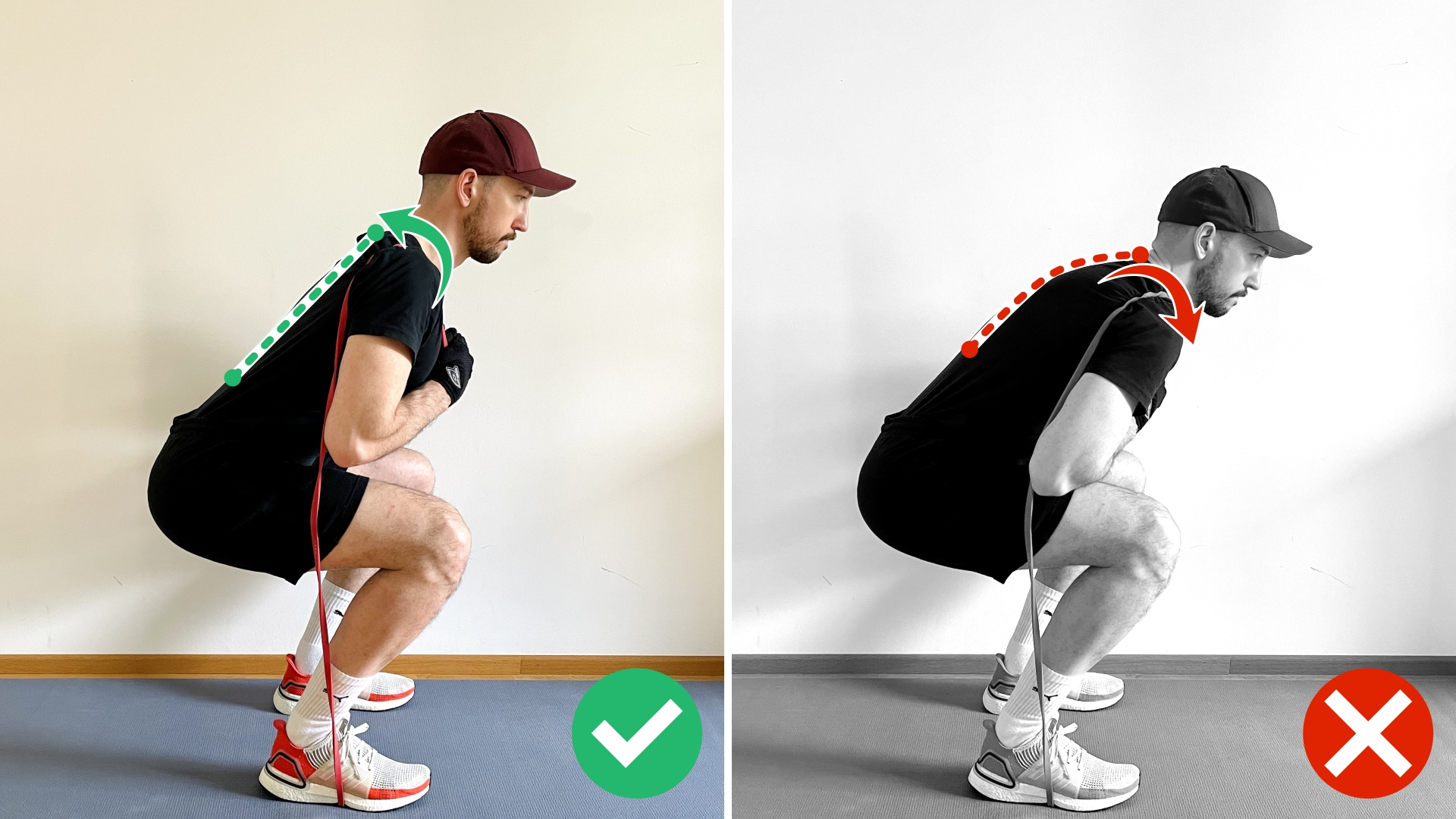
The rounding of the lower back can have many various reasons. But it usually has to do with mobility – either with hip or with ankle mobility. The best way to work on improving the mobility in your squat position and therefore the depth of your squat is by doing more squatting. You can do it with active squatting where you go up and down – I highly recommend doing body weight only – or by holding the full squat position for an extended amount of time.
But you can still do loaded squats while working on your mobility. But you need to limit the depth of the movement. To find out what the limit is, find a mirror and check at which position the lower back starts rounding. Set this as the limit and only squat to this depth and not further.

⓶ Inward Knee Collapse – this mistakes is quite common as well, but luckily very easy to fix. The first reason it occurs is simply because people don’t know that it is bad form and should be avoided. Your knees should be aligned over your toes throughout the movement, this is much safer for your knees tendons, and it is the strongest position of your knees. The second reason is a load which is too high. This often leads to the knees collapsing inwards.

⓷ Heels On The Ground – the usual reason for this to happen is limited ankle mobility, which we already discussed in the first point. Or not driving your hips backwards enough. Your hips need to go back and your shoulders forward. This way, the center of gravity stay right above your heels, and they don’t come off the ground. What you can try is taking two books (or anything else stable) and placing them under your heels. This approach will take the ankle mobility out of the picture, and you can do squats with correct form while still developing the needed mobility.
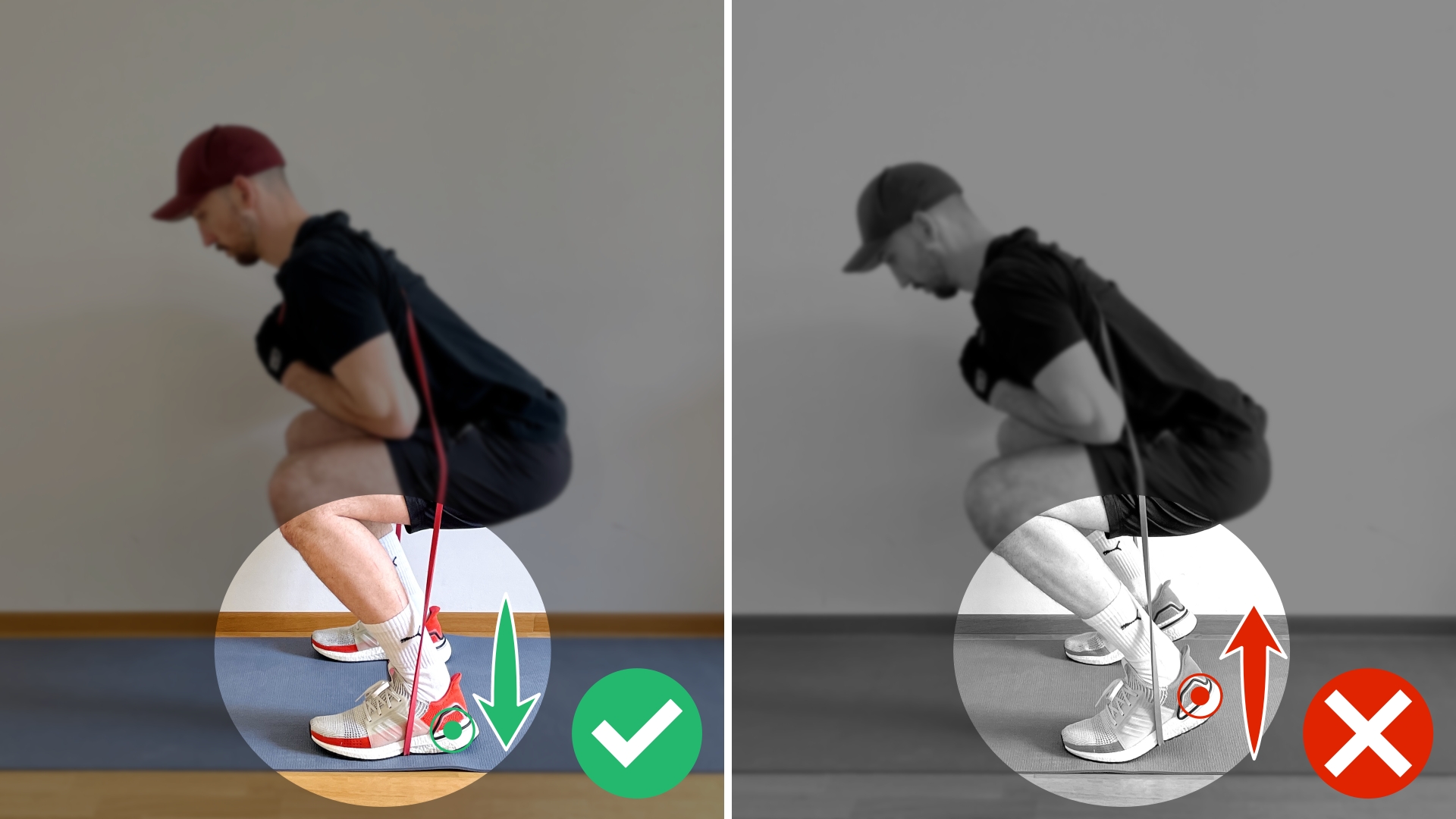
Keep these points in mind while squatting, and you will be able to move a greater load and stay away from injuries. Besides these specific mistakes for squats, there are also more general mistakes beginners do when start using resistance bands. To avoid doing them, read the following full article: The Worst Mistakes You Can Do When Training With Resistance Bands
How To Adjust The Intensity
There are more ways to increasing the intensity besides using a thicker band. Especially when it comes to resistance bands, simply grabbing the next heavier bands is not always the best idea. Since bands don’t have a constant resistance but instead a linear variable resistance profile, one band can generate a range of resistances instead of only one. Anyway, the best ways to increase the intensity in a squat are:
Shorten the band – the best way to shorten the band for a squat is wrapping it around one or both of your feet. It will make the band shorter enough that you will feel the difference in increased resistance, but won’t take it overboard.
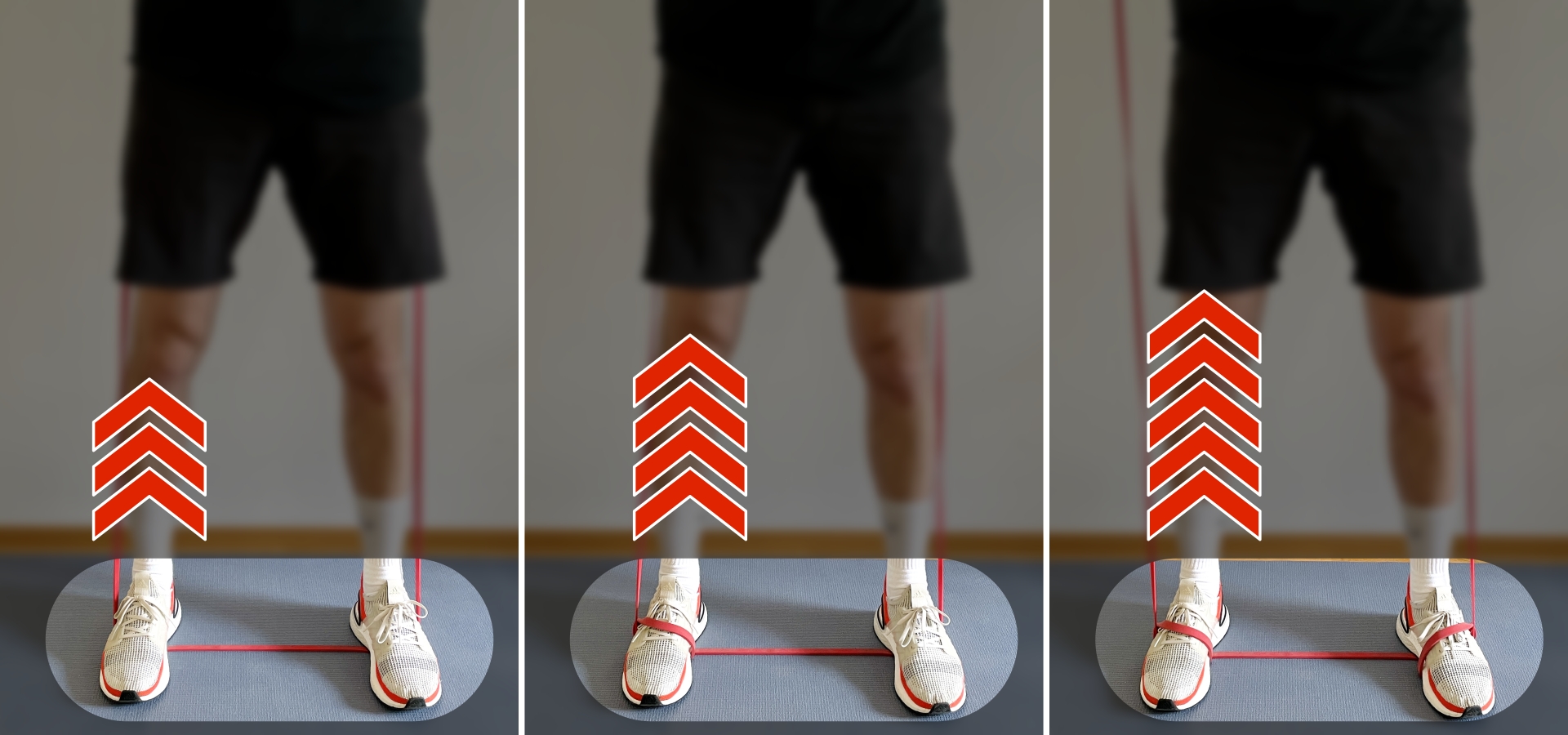
Add a second band – this is where a set of bands with different resistance levels comes in handy. I like to add the lightest band to the one I currently use if I feel like pushing my limits in that workout. This will add resistance, but will be less than using the next heavier bands. One more advantage is, that you can quickly get rid of the second band once you can’t do any more reps with the two band-set-up and knock out a couple more with the lower resistance.
Slow it down – increasing the resistance is not the only way to ramp up the intensity. The second dimension you can use is movement speed. By slowing down your motion during the squat, you will increase the total time under tension per repetition drastically. Therefore, you can get the same stimulus to the muscles with a lighter band.
Take a break – just kidding, of course. Well, you will take kind of a break, but it won’t be restful. Instead of slowing down the squat, you can keep the exercise speed the same but add a pause in the low position to increase the total time under tension.
High-Repetition Squats – I used to do the common reps and sets numbers for my squatting. Something like 10-12 reps and 3-5 sets. And it worked well. Muscles and strength went up…. and then a friend of mine dared me to try sets of 20-25 reps. The first time I did it, it felt like a cardio session, but with an incredible pump in the legs. You will have to lower the resistance with this approach, but this approach will give you superior carry over to other sports.
The BIQ App
Take training with resistance bands to the next level with our free app.
- 800+ Exercises
- all band types
- different training goals & workouts
- challenges
- much more
Alternative Ways To Do Squats With Resistance Bands
Implementing variations of a given exercise into your workouts is a safe way to keep your training engaging and more rewarding, as well as not letting your body get used to a motion pattern too much. We have some great ones for the squat:
Wide Stance Squat (Sumo Squat) – By changing the distance between your feet, you will change the muscle focus of the squat. Doing squats with a wider stance will involve the glutes much more compared to a narrower stance. Also, the upper body will be much more upright, which will result in less involvement of the upper and lower back. Make sure to keep your knees aligned with your toes and not let them collapse inwards.
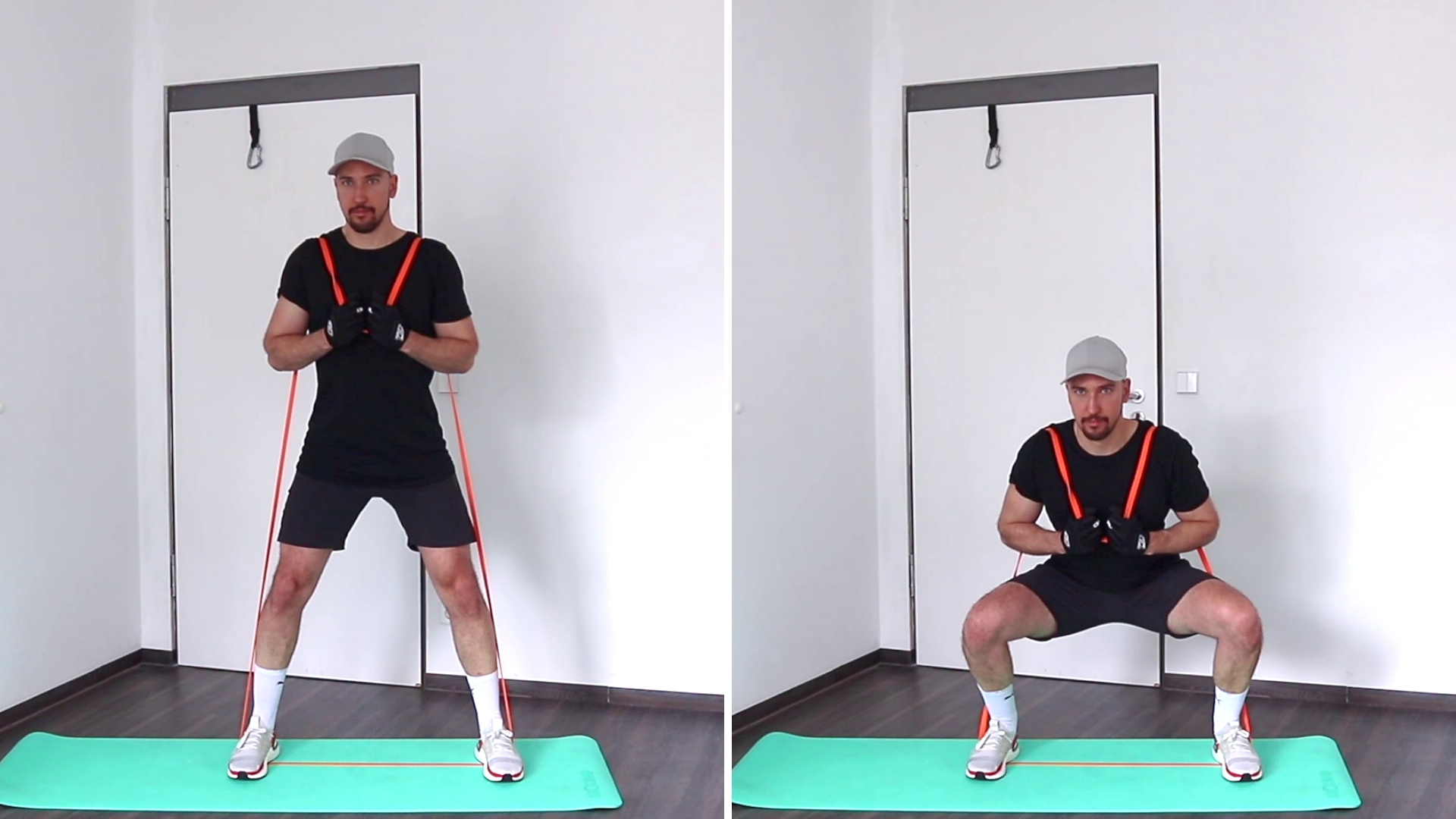
Overhead Squat – This is probably the toughest and most humbling squat variation. It will also demand some dedication to get the form right and acquire the need mobility to squat really low.
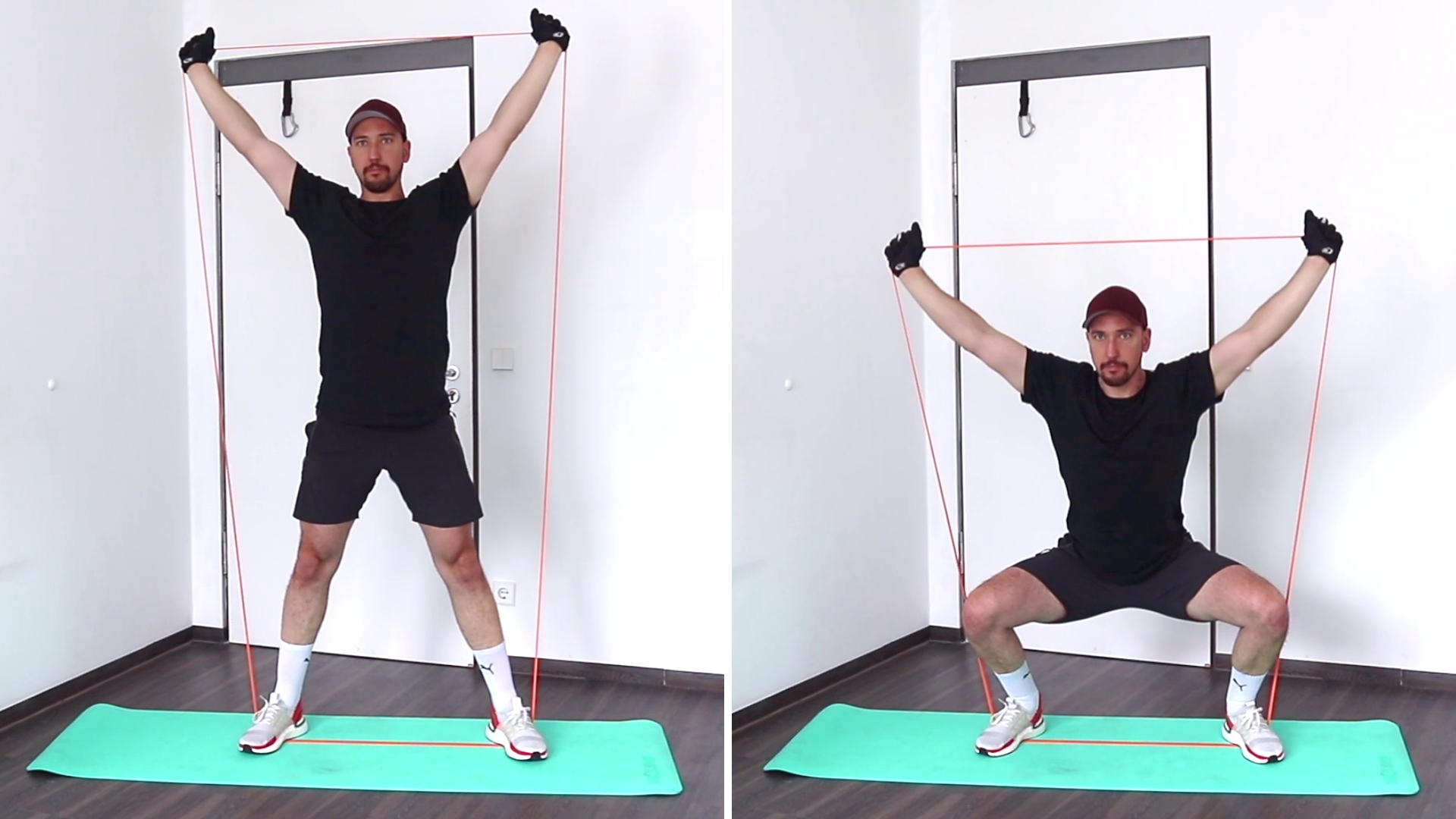
Push your hands over your head and keep them there throughout the squat. Make sure to lock your elbows out and don’t let them bend on the way down. Shoulder mobility plays a huge factor in this exercise. On the way down, your upper body will have to go forwards, however your hands shouldn’t change their position. It is important to keep this in mind and have the form in check. In the beginning, you will have to limit your range of motion and build it up over time.
And remember to use a lighter band here. You will stretch it much more since you have your hands over your head. And this results in a higher resistance.
Split Squat – A split squat is a unilateral variation, so you will train one side at a time. You will notice that it has much fewer demands on the needed mobility to get the form 100% right. The setup is quite straight forward. Hold the band with both hands and step in it with one foot. Step with the other foot back, so you are in a wider split stance position. From here, keep your upper body upright and lower the knee of the rear leg towards the floor until you touch it. Reverse the movement and extend both legs to full extension.
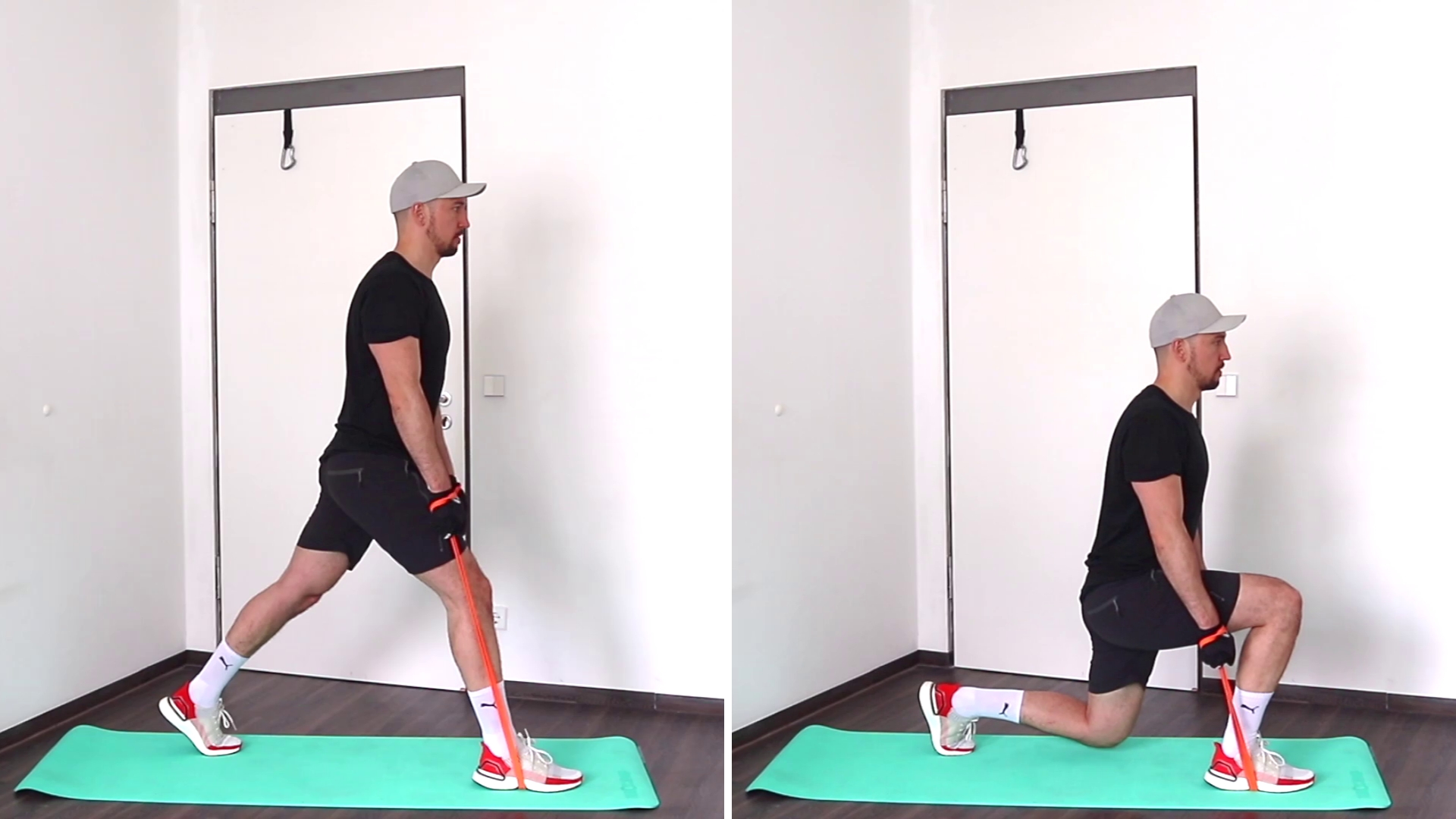
Pistol Squat – Pistols are the toughest unilateral squat variation. But you can actually use resistance bands to make it easier and use it as a preparation for a full pistol squat. To get started, attach the band to a door anchor at around head level. Grab the band with one hand and move away from the anchor point until there is tension in the band. The further you move away, the easier the pistol squat will become, since the bend will assist much more in the movement.
Now lift one foot off the floor. Bend the knee of the working leg and move your hips back. The other leg stays off the floor and moves forward while you go down. A good way to limit the range of motion when just starting out with pistol squatting is using something to sit down on.
Squat Hold – Instead of doing repetitions and going up and down, you can also try squat holds, where you will hold the bottom position for an extended amount of time. This becomes really challenging quite fast and is almost a cardio workout after a while. To get my mind something to do, I like to do straight punches in the air while holding the squat. You can do the punches with or without a resistance band.
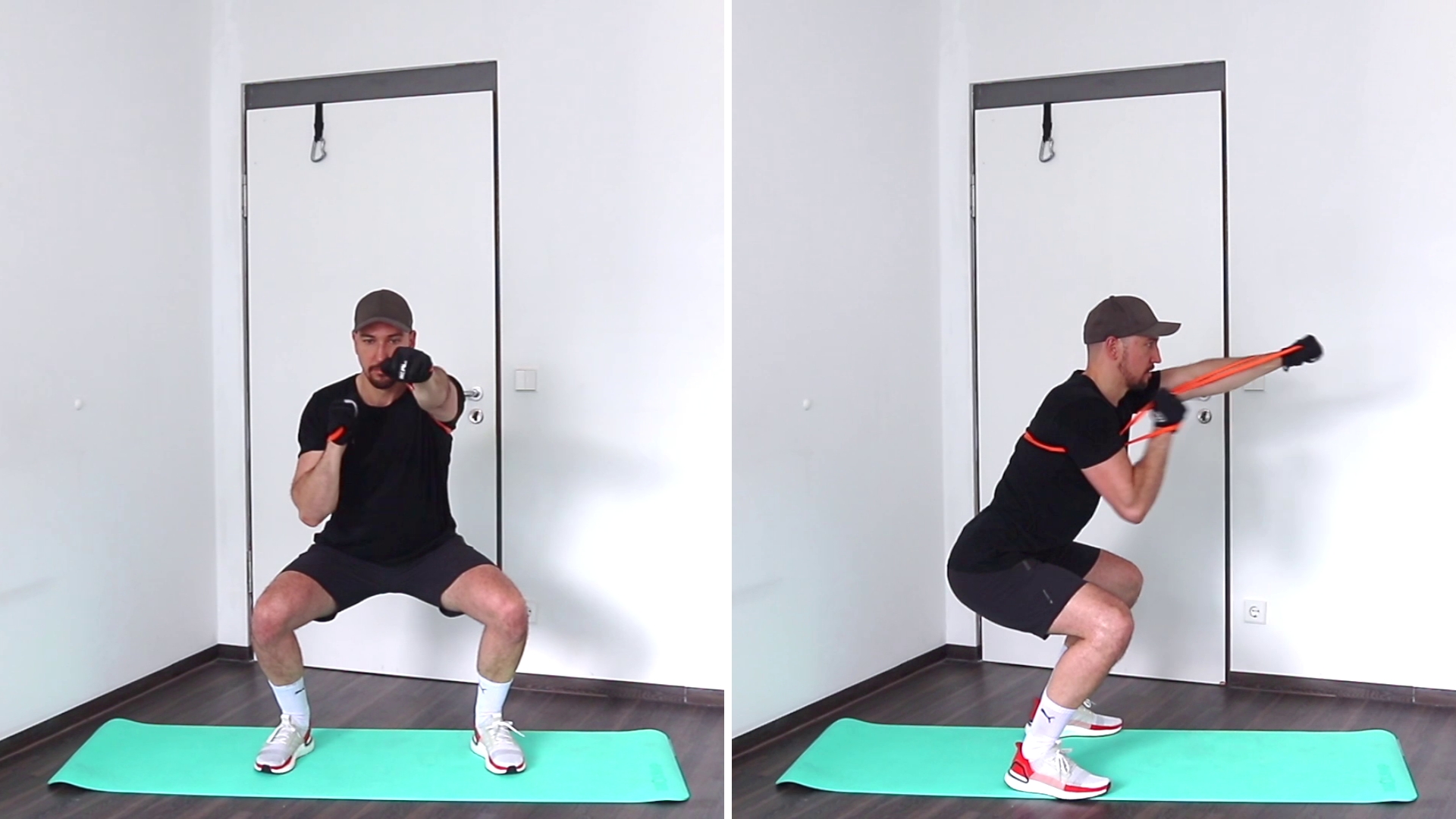
Can You Train Your Legs Effectively With Resistance Bands?
Times when resistance bands were only useful for warming up and mobility work lie in the past. Today, bans can generate enough resistance to stimulate muscle/strength growth or support fat loss. Especially if you can’t or don’t want to go to a gym and want to have great leg workouts at home (or anywhere else) resistance bands are the go-to tool. In addition, they are much more affordable than setting up a home gym.
So the short answer would be: Absolutely YES
Why it actually works, we will discuss in the next section. To be fully transparent, one more thing on the effectivity of resistance band use for squats. There is a limit to the resistance you will be able to use when using bands for squatting. Since you won’t be using a rack and therefore will have to get the band in the starting position by using your upper body muscles, there is a limit. So if your goal is moving a lot of weight and really push your strength potential, you will have to use a squat rack. But if you want to have functional lower body strength, lean and muscular legs, resistance bands will get you there at least as well as weights would.
Why Does Training With Resistance Bands Work
We are in luck that our muscles can’t tell the difference between weights, machines, rocks, furniture or resistance bands. All muscles know is resistance. If they have to move while a resistance is present, our body will make these muscles stronger and bigger. Of course, if the load is sufficiently high. This resistance can be generated by weights in combination with gravity – or by stretching a resistance band, where gravity doesn’t play a role. The resistance in a band is generated by the elastic characteristic of the material. Where the more you stretch it, the more it wants to return to its original (unstretched) state. And since gravity is not involved in this process, you will have much more freedom how you want to do exercises.
A full on deep dive into this topic you can check out in this article: Why Does Training With Resistance Bands Work
Benefits Of Training With Resistance Bands
Resistance band training has quite some advantages over using weights and machines. When it comes to squatting, some are:
- Joint Health! Less resistance in weaker angles of your legs also results in less stress on the joints and therefore in less risk of injury or overuse. In a squat, it is the bottom position, where the knees and the lower back are in a weaker position compared to the top position.
- Cheap, Mobile and Versatile! For a price of a couple of monthly gym fees, you will get a full set of resistance bands, which will enable you to effectively work every muscle in your body. In addition, you can fit them in any bag, bring them along on trips to get your workouts in and be fully flexible with your time.
Of course, there are a lot more advantages. We have a full article about this topic for you right here: Benefits Of Resistance Band Training
What Muscles Are Used In A Resistance Band Squat
The main muscles working in a squat are the quads (front muscles of the upper leg) and the glutes. Additionally, all other muscles of the lower body will be supporting the movement. Especially the hamstrings (back muscles of the upper leg) are playing a huge stabilizing role, as well as the calves.
Main Working Muscles:
- Quadriceps
- Glutes
Main Supporting Muscles:
- Hamstrings
- Calves
Workout Routine
Congratulations! Today you learned how to do a perfect squat, what muscles you use in this exercise and what variations exist out there. The next step is implementing squats in your training and performing them on a regular basis. This way you will get the motion pattern engraved in your body and become stronger. However, even though so many muscles are involved into squatting, one exercise alone is not enough to become really fit and have a functional body. The best way to achieve this goal is by following a workout program, where you train every muscle in your body throughout the week.
Our mission is to give people who want to train with resistance bands the best information out there how to do it correctly and effectively. That’s why we set out and developed a training app, which is basically a personal training in your pocket who is available at all times.
In there you will find customized workout programs depending on your available time and your goals, as well as single workouts which you can do whenever you have time. You can try various challenges to spice up your training, and whenever an exercise is not clear you will find help in the packed exercise library. Sound interesting?
Find out more here: BIQ Training App

